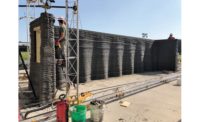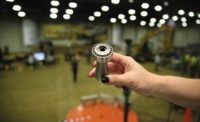Last month, Megan Kreiger spent more than a week at Camp Pendleton in Southern California, 3D printing a 32-ft-long reinforced concrete footbridge. When she first arrived, it rained so much there were mud slides. “It’s hard to print in torrential downpours,” she says. “It was crazy.”

The skies eventually cleared, and the bridge, her latest research project, printed. After all work on the custom gap crossing is done, Kreiger aims to 3D print a modern-day version of a Bailey bridge. “It would be phenomenal if we could make a bridge that could support a tank,” she says.
The footbridge pilot project came on the heels of a successful Kreiger-led research project—the first full-scale 3D-printed reinforced concrete building in the U.S. engineered for permitting. The 8-ft-tall walls of the 32-ft x 16-ft barracks were created using a deployable printer, designed to be run by military crews in remote places. The goal is to provide improved and safe housing—quickly and just about anywhere, no formwork needed.
Kreiger lives in Champaign, Ill., with her husband, two children and three 3D printers. One she even built herself. The family has printed an orange juicer, magnets, brackets and self-scans.
She became aware of 3D printing at Michigan Tech, where she ran the 3D printing lab during graduate studies in material science and engineering. She joined the U.S. Army Engineer Research and Development Center in February 2015. Her title is mechanical engineer.
Captain Matt Friedell, program manager for the Marine Corps Systems Command’s construction additive manufacturing—the main sponsor of the printed barracks project—knew when he first met Kreiger, in 2016, that she had a passion and vision unrivaled in the field of construction-scale AM. “She spoke in grand terms of where the technology will take humanity in the future,” he says. “She took that vision and used it as the kindling to ignite others’ imaginations.”
Kreiger sees huge implications for the limited labor required to create custom concrete structures without formwork. And 3D printing makes concrete work less physically taxing, she adds.
“My goal is to establish additive construction as a viable method and introduce the benefits of large-scale 3D printing to military and commercial construction,” says Kreiger. “I want to push forward and test the limits of the construction industry” through 3D printing.






Post a comment to this article
Report Abusive Comment